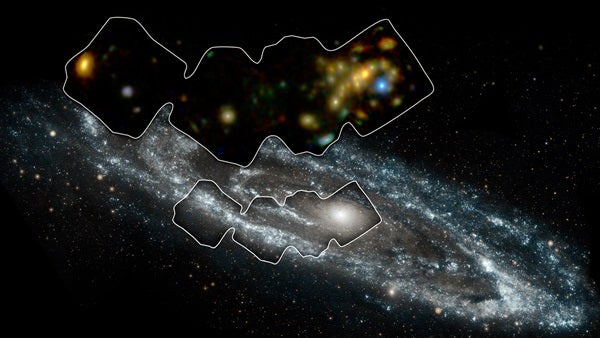The object, known as Swift J0042.6+4112, has been seen in lower-energy X-rays for decades. NASA’s Einstein Observatory first spotted the source in low-energy X-rays in the 1970s. The Swift satellite also saw it in 2013, but the object’s nature was still difficult to tease out among the many other low-energy X-ray sources nearby. Swift J0042.6+4112 has also been observed with the Chandra X-ray Observatory and the European Space Agency’s X-ray Multi-Mirror Mission (XMM-Newton).
Now, NuSTAR’s capabilities have finally allowed astronomers to make an educated guess as to the source’s nature. In a recent paper published in The Astrophysical Journal, first author Mihoko Yukita of Johns Hopkins University and her co-authors present a detailed study of the object, concluding that it is most likely a pulsar residing in a binary star system. As it pulls material off its close neighbor, the pulsar spits out X-rays. The nature of these X-rays closely matches the X-rays given off by pulsars in the Milky Way, leading the researchers to conclude that Swift J0042.6+4112 is the same type of object.
“We didn’t know what it was until we looked at it with NuSTAR,” said Yukita in a press release. That’s because NuSTAR provided the final piece of the puzzle — the nature of Swift J0042.6+4112’s high-energy X-ray emission, which was not observable with other telescopes.
The identification of Swift J0042.6+4112 as a pulsar is strange, however, because astronomers would expect emission from the infall of matter onto a central supermassive black hole to dominate the high-energy X-rays emerging from the galaxy. That’s because supermassive black holes are millions of times more massive than pulsars. Andromeda’s supermassive black hole tips the scales at 100 million solar masses (1 solar mass is the mass of our Sun). By comparison, the Milky Way’s central supermassive black hole is only about 4 million solar masses. And a pulsar, by nature, can’t grow to more than about three solar masses before it collapses and eventually forms a stellar-sized black hole.
That’s why this result is so intriguing, but also so important for the study of pulsars in our own galaxy and beyond. Ann Hornschemeier of NASA’s Goddard Space Flight Center, one of the paper’s co-authors, explained, “NuSTAR has made us realize the general importance of pulsar systems as X-ray-emitting components of galaxies, and the possibility that the high energy X-ray light of Andromeda is dominated by a single pulsar system only adds to this emerging picture.”










